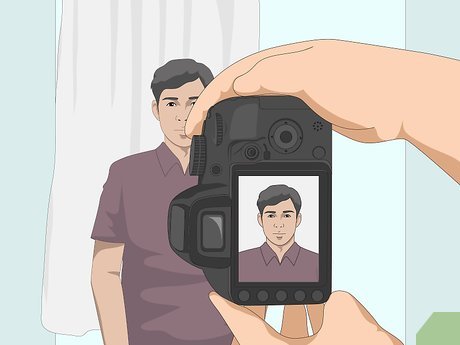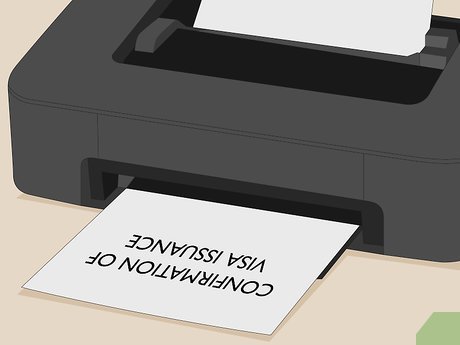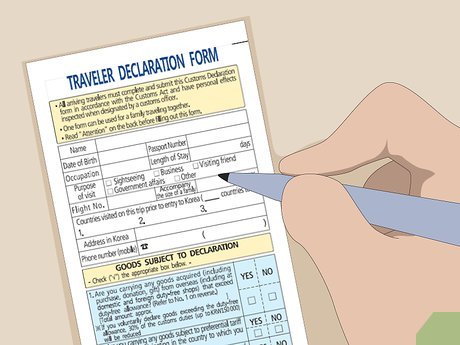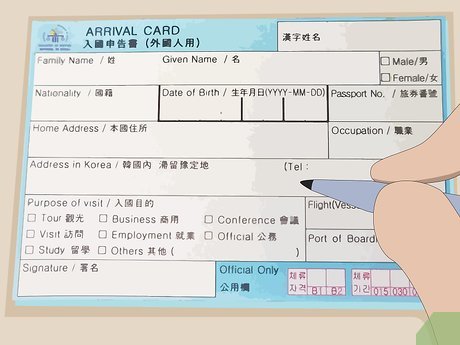If you want to travel to the Republic of Korea (South Korea) for a short visit as a tourist, you typically don’t need a visa. However, if your trip is going to take more than 90 days (30 days for nationals of some countries), you’ll need a tourist visa. You can apply for a tourist visa either online or at the Korean embassy or consulate closest to you. Immigration officers will give you your visa when you go through customs at the port of entry.X
StepsPart 1Part 1 of 3:Completing a Visa Application
1Determine if you need a tourist visa. Nationals of most countries can travel to Korea as a tourist for a short period without a visa. Typically, you can stay up to 90 days, although in some countries the duration is limited to 30 days.XIf you plan to stay in Korea for longer, you still need a visa, even if you are going to Korea to participate in tourist activities.For a list of countries that have been granted visa-free travel to Korea, visit https://english.visitkorea.or.kr/enu/TRV/TV_ENG_2_1.jsp.
2Choose the visa category that best suits your reason for travel. Generally, B and C visa categories apply to short-term visits. Typically, you’ll want the general tourist visa, B-2. However, there are other tourist visas that might be more appropriate for you depending on your country of origin.XFor example, if you are a Chinese national and are traveling to Korea with a tour group, you would need a C-3-2 group tourist visa.Use Korea’s Visa Navigator, available online at https://www.visa.go.kr/openPage.do?MENU_ID=10101, to determine which visa category is right for you.
3Have a passport photo taken. You can find professional passport photo services at most pharmacies, discount stores, and photography shops. The photo for your visa should be less than 3 months old and different from the photo you’re using on your passport, even if you’ve gotten your passport recently.XIf you’re planning to submit your application online, make sure you have a digital copy of your passport photo that you can upload.
4Complete your visa application form. The application form is available online through Korea’s Visa Portal at https://www.visa.go.kr. To start your application online, click on “Application,” then select “E-Visa (Individual).”XThe application requires you to provide information about yourself, your citizenship, and your reasons for wanting to visit Korea. Answer every question completely and honestly.You can also fill out a paper application at the Korean embassy or consulate nearest you. To find contact information, go to http://www.mofa.go.kr/eng/index.do and select the name of your country from the drop-down menu at the top of the page.
Tip: A past criminal conviction or other negative information won’t necessarily cause Korean immigration officials to deny your tourist application. However, your application will be denied if they discover that you lied on your application or left out any relevant information.

5Gather documents required for your visa type. At a minimum, you’ll need your passport or copies of the bio pages of your passport. Your passport must have at least 3 months of validity remaining when you enter Korea. Other documents you’ll need depend on the type of tourist visa you’ve applied for and what you plan to do in Korea.XFor example, if you are a Chinese national traveling with a tour group on a group tourist visa, you’ll need a confirmation page showing that you’re booked for the tour, along with information about the tour company and where you’ll be staying while you’re in Korea.You’ll likely need to show that you have a return flight out of the country before your visa expires along with information about your accommodations in Korea. If you’re staying with friends or family while in Korea, you’ll likely need a letter from them.Part 2Part 2 of 3:Submitting Your Application
1Use the visa portal to submit your application electronically. If you submit your completed application through the portal, you can use your account there to track the status of your application. Any communication from the Korean immigration officials who review your application will also be sent through the portal.XIf you submit your application electronically, you must also pay your application fee electronically. The amount of your application fee varies depending on your country of origin. The visa portal accepts major credit and debit cards for payment.
Warning: You don’t necessarily have to pay your application fee at the same time that you submit your completed application. However, your application won’t be processed until after the fee is paid.

2Locate the nearest Korean embassy or consulate to submit your application in person. If you suspect there may be questions or issues regarding your application, you may want to submit it in person. This will give you the opportunity to talk to a Korean consular officer directly about your application. Go to http://www.mofa.go.kr/eng/index.do and select the name of the country where you live from the drop-down menu at the top of the page. You’ll see contact information for all of the Korean embassies and consulates in your country. Simply pick the one that’s closest to you.If you’re submitting your application in person, you can still fill out the application online if you want. Print the completed application and take it with you to the Korean embassy or consulate.
Warning: If you submit your application in person, you must pay your application fee immediately. Call ahead to find out what methods of payment are accepted. Many Korean embassies and consulates don’t take credit or debit cards.

3Wait for confirmation from your sponsor if you have one. If you’re staying with friends or family or have an organization sponsoring you, they’ll need to confirm the details of your visit that you provided on your application. Contact them and find out if they’ve been contacted yet. You want them to confirm your application as soon as possible to avoid delays.XFor example, if you are visiting Korea as a medical tourist to have a medical procedure done as well as engage in tourist activities, you typically need confirmation from the doctor or from the hospital where the procedure will take place.Most tourist visas don’t require a sponsor. However, if you’re concerned that your application might be denied, a sponsor might help improve your chances.
4Find out if your visa has been issued. Generally, visa applications are processed within 5 business days. If your situation is more complex or if the consular officer needs additional documentation, there could be delays. Electronic visas will be programmed into your passport. You’ll get the print visa when you go through customs at the port of entry.If you need a paper visa in your passport before you depart for Korea, you’ll have to turn over your passport to the nearest embassy or consulate. When your visa is ready, they’ll mail your passport back to you with the visa inside.If your application is denied, you typically won’t be told why. However, you’re welcome to reapply immediately. No part of your application fee will be refunded if your application is denied and you’ll have to pay the fee in full again if you decide to apply again.Part 3Part 3 of 3:Traveling to Korea
1Print your confirmation that your visa has been issued. If you applied for your visa online through the visa portal, check your email for confirmation. You can also print the confirmation from your account on the portal. Keep the confirmation page with your passport and any other travel documents.XIf you applied for your visa in person at a Korean embassy or consulate, you’ll get a confirmation letter in the mail. Take that confirmation letter with you when you travel to Korea.
2Complete a declaration form for your belongings. At the port of entry, you’re expected to declare exactly what you’re bringing into the country. Customs officers may inspect your baggage to confirm that the items you’ve brought match up with the items you listed on your declaration form.XIf you bring something with you that is not allowed in Korea, it will be confiscated and you may not get it back. To avoid this, check the list of items that aren’t allowed before you start packing for your trip.
3Fill out your arrival card on the plane. As you near Korea, the flight attendants will hand out arrival cards for all non-Korean nationals to fill out. The arrival card lists your name and passport details along with information about your flights into and out of the country.XRead the instructions carefully and make sure you enter your information neatly and legibly.
4Present your passport and paperwork to the immigration officer. When you enter customs, you’ll see two lines: one for Korean nationals and one for others. Get in the line for non-Korean nationals and have your passport, visa confirmation, declaration form, and arrival card ready.XThe customs officer will look over your paperwork and confirm your identity. They may also ask you questions about your trip or your plans in Korea.If the customs officer approves you to enter the country, they will place your visa in your passport. Pay close attention to the date your visa expires and make sure you’ve left the country before that date. While you can try to extend an expired tourist visa, it is a difficult process with no guarantees.
Warning: Having a visa does not guarantee that you will be allowed to enter Korea. Korean immigration officers have broad authority to determine who will be allowed into the country.

5Visit a Tourist Information Center (TIC) if you have any questions. The TICs at international airports and at the K-Style Hub in Seoul offer information and resources for all types of tourists in Korea. At the TIC, you can learn about Korean attractions as well as other facilities and resources available for tourists.XThere are also two Medical TICs at the Busan and Incheon International Airports. At these TICs, you can learn about medical tourism and get a free customized consultation if you think medical tourism might benefit you.








